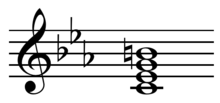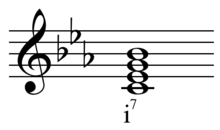- Nondominant seventh chord
-
In music theory, a nondominant seventh chord is a chord which is a diatonic chord that is a seventh chord but that does not possess dominant function[2] and thus is not a dominant seventh chord.
Since the V and viio chords are the dominant function chords,[2] the "major minor seventh" V7 and "half-diminished seventh" viiø7 are the dominant seventh chords. Since the nondominant function chords are I, i, ii, iio, iii, III, IV, iv, vi, and VI,[2] the nondominant seventh chord qualities include the augmented major seventh chord, major seventh chord, minor major seventh chord, minor seventh chord, and major minor seventh chords that do not possess dominant function such as, in harmonic minor, IV
 .
.To analyze seventh chords indicate the quality of the triad; major: I, minor: ii, half-diminished: viiø, or augmented: III+; and the quality of the seventh; same: 7, or different:
 or
or  .[2] In macro analysis indicate the root and chord quality, and add 7, thus a seventh chord on ii in C major (minor minor seventh) would be d7.[1]
.[2] In macro analysis indicate the root and chord quality, and add 7, thus a seventh chord on ii in C major (minor minor seventh) would be d7.[1]As with dominant seventh chords, nondominant seventh chords usually progress according to the circle progression, thus III+
 resolves to vi or VI,[4] for example.
resolves to vi or VI,[4] for example. Nondominant seventh chords are, "found in large number," in popular music and jazz ("a legacy from the romantic period"), such as in this example from "Try To Remember" (The Fantasticks) by Harvey Schmidt (lyrics: Tom Jones)[4]
Nondominant seventh chords are, "found in large number," in popular music and jazz ("a legacy from the romantic period"), such as in this example from "Try To Remember" (The Fantasticks) by Harvey Schmidt (lyrics: Tom Jones)[4]
 Play (help·info). Note the circle progression derived root motion by fourths/fifths.
Play (help·info). Note the circle progression derived root motion by fourths/fifths.When possible, as in circle progressions, resolve the seventh of nondominant seventh chords down by step to the third of the following chord.[3]
See also
- Irregular resolution
- Dominant ninth, etc.
- Dominant seventh flat five chord
Sources
Degrees and functions of the diatonic scale Chords By type - Major
- Minor
- Dominant
- Dominant seventh flat five
- Diminished
- Half-diminished
- Diminished major
- Minor-major
- Augmented major
- Augmented minor
- Nondominant
- Harmonic seventh chord
- Ninth
- Eleventh
- Thirteenth
- Upper structure
Added
/ omitted- Sixth
- Minor sixth
- Augmented sixth
- Power chord
- Lydian chord
- Seven six chord
By function Secondary- Secondary dominant
- Secondary leading-tone
- Secondary supertonic
With names - Elektra chord
- Farben chord
- Hendrix chord
- Mu chord
- Mystic chord
- Northern lights chord
- Petrushka chord
- Power chord
- Psalms chord
- So What chord
- Spider chord
- Tristan chord
- Viennese trichord
- Dream chord
Other - Common chord (music)
- Mixed interval
- Open chord
- Polychord
- Primary triad
- Quartal and quintal
- Slash chord
- Subsidiary chord
- Synthetic chord
- Tone cluster
Categories:- Seventh chords
Wikimedia Foundation. 2010.














